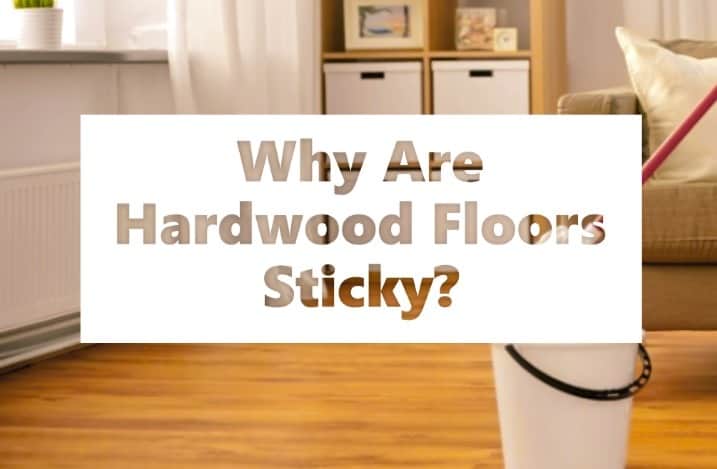Table of contents

Hardwood floors are renowned for their timeless beauty and durability, making them a popular choice for homeowners. However, encountering sticky hardwood floors can be a frustrating and perplexing issue. In this article, we will delve into the ten common reasons behind sticky hardwood floors and provide practical solutions to address each cause effectively.
1. Residue Buildup:
One of the most common culprits behind sticky hardwood floors is residue buildup. This residue can result from improper cleaning techniques, using the wrong cleaning products, or not thoroughly removing cleaning solutions. Over time, residue accumulation can create a sticky film on the surface of the hardwood.
Solution:
Regularly clean your hardwood floors using appropriate cleaning products specifically designed for wood surfaces. Ensure thorough rinsing after cleaning to remove any leftover residue.
Also Read: Best Vacuum For Vinyl Floors
2. Excessive Use of Cleaning Products:
Using an excessive amount of cleaning products or failing to dilute them properly can leave behind a sticky residue. Cleaning agents containing oil-based or wax components are more likely to cause stickiness on hardwood floors.
Solution:
Follow the manufacturer’s instructions when using cleaning products and use them sparingly. Dilute concentrated solutions as directed, and avoid using oil-based or wax-based cleaners on hardwood floors.
3. Spills and Stains:
Accidental spills of sticky substances such as food, beverages, or household items can lead to sticky hardwood floors if not promptly cleaned. These spills often seep into the gaps between the floorboards and become difficult to remove.
Solution:
Clean up spills immediately using a damp cloth or mop. Avoid using excessive water, as it can damage the wood. For stubborn stains, use a specialized wood floor cleaner and gently scrub the affected area.
4. Humidity and Moisture:
High humidity levels and excessive moisture can cause hardwood floors to absorb the moisture, leading to swelling and stickiness. This can be particularly problematic in areas with inadequate ventilation or in regions with naturally high humidity.
Solution:
Maintain appropriate humidity levels in your home by using dehumidifiers or air conditioners. Clean up any spills or water leaks promptly, and ensure proper ventilation to prevent excess moisture accumulation.
5. Improper Floor Finishing:
Inadequate or improper application of floor finishes can result in sticky hardwood floors. Insufficient drying time, uneven application, or using low-quality finishes can all contribute to a sticky residue on the surface.
Solution:
Ensure proper preparation and application of floor finishes according to the manufacturer’s instructions. Allow sufficient drying time before walking on the floors, and consider using high-quality finishes for better results.
6. Wax Buildup:
Waxing is a common maintenance practice for hardwood floors, but excessive or improper waxing can lead to sticky and dull-looking surfaces. Over time, wax buildup can attract dirt and grime, resulting in a sticky residue.
Solution:
Strip away old wax layers using a wax stripper or specialized wood floor cleaner. Thoroughly clean the floor, allow it to dry completely, and apply a fresh coat of wax using the appropriate techniques.
7. Inadequate Cleaning:
Insufficient or improper cleaning can contribute to sticky hardwood floors. Dust, dirt, and other particles can accumulate on the surface, combining with moisture or cleaning agents to create a sticky mess.
Solution:
Regularly sweep or vacuum your hardwood floors to remove dust and dirt particles. Use a damp mop or cloth to clean the surface gently, ensuring that excess water is avoided.
8. Damaged Floor Finish:
Worn-out or damaged floor finishes can make hardwood floors susceptible to stickiness. Scratches, abrasions, or flaking of the finish can expose the underlying wood, making it more prone to moisture absorption and stickiness.
Solution:
Assess the condition of your floor finish regularly and address any signs of damage promptly. Recoat or refinish the hardwood floors as needed to restore their protective layer. Consider using durable finishes or adding an additional layer of protection, such as a polyurethane sealant, to prevent future damage.
9. Low-Quality Cleaning Tools:
Using low-quality or worn-out cleaning tools, such as mops with dirty or abrasive surfaces, can leave behind residue or scratch the hardwood floors. These factors can contribute to stickiness over time.
Solution:
Invest in high-quality cleaning tools specifically designed for hardwood floors. Opt for microfiber mops or soft, non-abrasive cloths that effectively trap dirt and debris without causing damage. Regularly clean or replace the cleaning tools to maintain their effectiveness.
10. Improper Maintenance:
Lack of proper maintenance, including neglecting routine cleaning and failing to address issues promptly, can lead to sticky hardwood floors. Regular care and attention are essential to keep the floors in optimal condition.
Solution:
Implement a consistent maintenance routine for your hardwood floors. This includes regular sweeping or vacuuming, prompt cleaning of spills or stains, and periodic deep cleaning. Stay proactive in addressing any issues promptly to prevent them from escalating.
Conclusion:
Sticky hardwood floors can be a frustrating problem, but understanding the underlying causes can help you tackle the issue effectively. From residue buildup to improper maintenance, various factors can contribute to stickiness. By implementing the solutions provided, including proper cleaning techniques, prompt spill cleanup, maintaining appropriate humidity levels, and addressing damaged finishes, you can restore the beauty and functionality of your hardwood floors. Remember, regular care and maintenance are crucial to ensure long-lasting, non-sticky hardwood floors that will continue to enhance the aesthetic appeal of your home.
